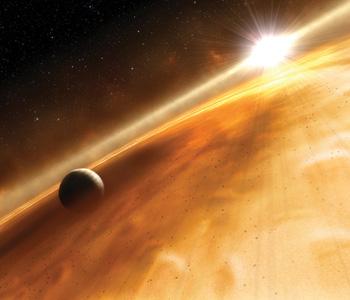Feature
Exoplanets: Getting a Closer Look
Sophisticated new techniques are directly imaging giant planets outside of our solar system and recording spectra that reveal the composition of their atmospheres. And telescopes capable of directly imaging Earth-sized exoplanets are on the technological horizon.
 An artist’s impression of an exoplanet orbiting Fomalhaut. NASA
An artist’s impression of an exoplanet orbiting Fomalhaut. NASA
For most of the 20th century, astronomers had no solid evidence that planets existed outside of our solar system. The first widely accepted exoplanet discovery came in 1992, when regular variations in the period of pulses from a millisecond pulsar—a rapidly spinning neutron star—showed the presence of two planets. Three years later, the first extrasolar planet orbiting a main-sequence star—a Jupiter-sized giant a mere seven million kilometers from its sun—was discovered from periodic changes in Doppler shifts of stellar spectral lines. And 1999 brought the first successful detection of an exoplanet transit across the face of its host star.
…Log in or become a member to view the full text of this article.
This article may be available for purchase via the search at Optica Publishing Group.
Optica Members get the full text of Optics & Photonics News, plus a variety of other member benefits.
